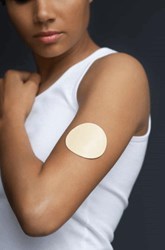New Patch Technology Will Help Scintilla Treat Pain

By Ed Miseta, Chief Editor, Clinical Leader

Scintilla Pharmaceuticals, a subsidiary of Sorrento Therapeutics, has announced it will acquire SCILEX Pharmaceuticals to bolster its pain management business. Scintilla's top program is resiniferatoxin, used for the treatment of intractable cancer pain. SCILEX is engaged in the development and commercialization of products focused on the treatment of pain. Its lead product candidate, ZTlido (lidocaine patch 1.8%), is a branded lidocaine patch formulation being developed for the treatment of postherpetic neuralgia, the chronic pain that sometimes develops with shingles. The underlying patch technology can be adapted to other applications as well.
In July 2015, SCILEX filed a new drug application (NDA) for ZTlido. The SCILEX team is preparing a planned NDA re-submission for a potential FDA action date in mid-2017. In addition to ZTlido, the SCILEX pipeline includes line extensions of ZTlido as well as other novel patch technologies in development.
With its patch technology, SCILEX was hoping to solve safety issues that currently exist with existing pain medication patches. The biggest issue is the large amount of medication contained in the patch and the small amount that is ultimately delivered to the patient.
 For instance, the current standard of care is LIDODERM (Lidocaine Patch 5%), a product produced by Endo Pharmaceuticals. It, too, relieves the pain of post-herpetic neuralgia. LIDODERM was approved for use by the FDA in March 1999, and a generic version is currently available.
For instance, the current standard of care is LIDODERM (Lidocaine Patch 5%), a product produced by Endo Pharmaceuticals. It, too, relieves the pain of post-herpetic neuralgia. LIDODERM was approved for use by the FDA in March 1999, and a generic version is currently available.
Prior to the acquisition announcement, I spoke to Kip Vought, VP of development at SCILEX, and he told me the Endo Pharmaceuticals patch contains over 600 milligrams of the active ingredient (lidocaine), yet only a fraction of that actually gets delivered to the patient. “That is a very inefficient system and also leaves a lot of residual drug in the patch, which can be a safety concern,” he says. “We looked at that situation and felt we could do better. We have manufactured a patch with only 36 milligrams of the drug. It delivers a similar amount of medicine to the patient, and does so with excellent adhesive properties.”
No Phase 3 study was performed to compare the new patch to LIDODERM, but that may be done in the future. However, Vought noted SCILEX did perform a comparative pharmacokinetics (PK) program to confirm the SCILEX product had the same rate of drug delivery as LIDODERM. Blood levels were checked to determine that the product was as safe and effective as the LIDODERM patch.
Improvements In Patch Technology
Vought credited the success of the SCILEX product on improvements in patch technology that have occurred over the last 15 years. When LIDODERM first hit the market in 1999, it featured technology that was considered cutting edge at the time (hydro-gel patch technology).
“This is an aqueous gel face patch,” said Vought. “The drug is diluted into a gel matrix, added to an adhesive layer, and then given a backing cloth and patch. In order for that that type of product to deliver the desired amount of medicine, you need to include a large amount of the drug in the patch. That is simply inherent in the properties of that type of system. The SCILEX patch uses a non-aqueous system that does not require as much heat to release the drug. This enables the patch to reduce the amount of drug that must be delivered to the skin, and improves the safety of the product to consumers by having less residual drug in the product.”
The active ingredient in LIDODERM is lidocaine, a local anesthetic that prior to development of the patch was primarily administered via injection. The pain that occurs after shingles is related to nerve damage in the skin, which is best treated with a drug delivered topically rather than via injection.
Adhesion And Skin Irritation Are Concerns
For a patch technology, proper adhesion is critical. If a patch is lifting at the edges, peeling off, or getting caught on patient clothing, it will not function properly and will not correctly deliver the medicine to patients. For that reason, SCILEX felt the adhesive properties of its patch were as important as the drug delivery mechanism.
“It is very frustrating for patients to use a patch that doesn't have good adhesive properties,” said Vought. “If it is ripping or falling off, that’s a challenge because in addition to the patient not receiving the right amount of the drug, they will have to keep reapplying the patch. Therefore, improving the adhesive properties was critical. We tested the patch clinically to ensure it would stay in place throughout the administration period.”
When patients apply a patch, they want to know that it will stay secured without added effort on their part. That responsibility lies with the manufacturer, and regulatory bodies are now asking manufacturers for adhesion data.
The adhesion study used by SCILEX involved a population of healthy volunteers who evaluated the adhesion through a well-established scale. The study looked at the effects of pressure, heat, and exercise. Heat can affect the adhesive properties of a patch but will also increase the rate of drug exposure. In the study, heat was tested with the use of a heating pad. Neither heat nor exercise had a significant effect on the delivery of the drug.
While it can be easy to get good adhesive properties from a patch, it can be difficult to do so without causing skin irritation. The trade-off between adhesion and irritation can be a challenge. Animal patch studies were performed to show the patch would have good adhesive properties while also exhibiting a minimal level of irritation. Vought believes SCILEX has managed to strike the right balance of adhesion, irritation, and drug delivery.
Get Regulatory Approval
FDA approval is always a concern for pharmaceutical companies, even when improving on an existing product. In fact, that scenario can bring about unique challenges, especially if the product you’re improving was developed in the 1990s.
Vought noted there is a sharp contrast between the regulatory requirements for a patch in the 1990s and today. The first thing a patch manufacturer needs to do is show bioequivalence to an existing product, per the FDA’s 505(b)(2) new drug application (NDA). This guidance was created, in part, to help avoid unnecessary duplication of studies already performed on a previously approved drug and gives the FDA express permission to rely on data not developed by the NDA applicant.
“It’s a mechanism that allows the FDA to approve a product on the basis of the safety and efficacy of an existing approved product,” said Vought. “But you still end up having to do additional studies to qualify the aspects of your product that are different than the one currently on the market. This is the stage in which we are operating.”
For Vought, the biggest surprise to come out of the study was the ability of SCILEX to achieve bioequivalence while using a substantially lower quantity of the drug. “This is an extended release patch,” he said. “The patch is worn for a period of 12 hours, but the medicine will accumulate on the skin and continue to be distributed for an additional 12 hours after the patch is removed. Initially I was skeptical that we could achieve equivalency with a 36-milligram patch, so I was pleasantly surprised with the results.”
SCILEX has a partner that purchases the drug in bulk quantities, compounds it within the adhesive mixture, and produces the final product.
SCILEX has plans to perform additional studies, pending regulatory approval. Additional studies will be to further define the characteristics of the patch and to look at other applications. The company would like to build its pipeline by extending the patch technology into other areas where Vought believes the SCILEX patch will exhibit greater safety and efficacy than products currently available.
Building the pipeline will be a challenge for the SCILEX development team. Vought noted there are a lot of interesting ideas and concepts out there, but his company will not pursue them unless they can provide benefits that currently don’t exist in the market. The company is investigating both new drugs and improved delivery of existing ones.
